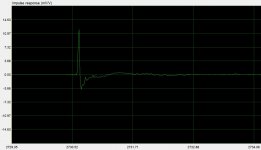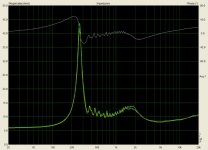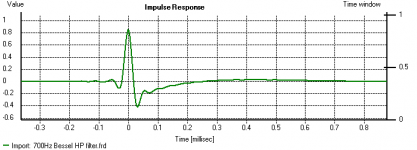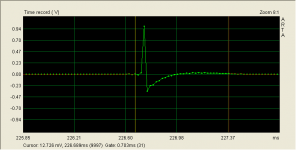That's why I look at the decay tail of impulse measurements: that's where the ESL57 is better than nearly any other loudspeaker (it has about the quickest, and most non-resonant, decay). This is the measurement that separates good horns from bad ones: many other horns have long and resonant decay characteristics, worse than many direct-radiators, while the LeCleac'h does a quite creditable imitation of an electrostat.
Hello,
To illustrate what Lynn said about the tail of the Impulse Response, here is a IR I obtained on last Sunday on one of my axisymetrical horn (Fc = 320Hz).
Best regards from Paris,
Jean-Michel Le Cléac'h
Attachments
Very nice looking, Jean-Michel!
I can't quite read the time units, but from the posted graphic, there's just a touch of pre-ringing (digital artifact), the expected impulse and a bit of overshoot, which then quiets down, then possibly a floor bounce as the signal re-appears after the next major division.
I can't quite read the time units, but from the posted graphic, there's just a touch of pre-ringing (digital artifact), the expected impulse and a bit of overshoot, which then quiets down, then possibly a floor bounce as the signal re-appears after the next major division.
Isn't the overshoot a normal part of the high pass filter?
Hello Pano,
The high-pass filter used for that IR measurement is a single 100 microfarad capacitor.
This capacitor is not the high-pass I generally use with a TAD TD2001 mounted on that horn (which is the high-pass of a quasi-optimal Le Cléac'h crossover so 3rd order) but was used to protect the driver from low frequency send to it during the logsweep of sine sent by ARTA.
So probably, as the resonance frequency of the river is 260HZ (see the green curve on the attached impedance cure obtained on last Sunday using Limp), the overshoot is due to a residue of that 260Hz resonance.
Best regards from Paris, France
Jean-Michel Le Cléac'h
Attachments
Thanks J-M.
Here is what an ideal Bessel high pass @ 700 Hz would look like as an impulse in HOLMImpulse and in ARTA. We see very much the same shape as Jean-Michel's measurement. The real measurement isn't perfect, but it's not far off.
Here is what an ideal Bessel high pass @ 700 Hz would look like as an impulse in HOLMImpulse and in ARTA. We see very much the same shape as Jean-Michel's measurement. The real measurement isn't perfect, but it's not far off.
Attachments
Be is a waste of money for a 200 Hz horn. Go for a Radian diaphragm in the 2446, it has mylar sourround which is not as stiff as titanium. Or swap the driver for a 248x with phenolium diaphragm, or use a BMS 4591
Don´t use this horn above say 3 kHz. You will need a smaller LeCleach above it. A TAD CD maybe? Or a Radian CD.
more10, JMMLC, Pano, thanks for the advice. That is very impressive impulse JM from a 320Hz horn. My friend has one of those, I hope to hear it soon.
I also have Radian 475PB 1" drivers. I didn't consider using that because of how bad it sounded in a SEOS12 horn. I would prefer to use the 200Hz horn alone without a separate tweeter. I'd like to have at least 12kHz extension with moderate beaming is OK. Is this possible? Or am I expecting too much from the big horn?
If you guys say that 2" driver can't do decent treble even in Le Cleac'h horn, then I'll build a smaller horn for the 1" driver instead. But how low can that play? Do I really want a crossover in that delicate range of 1kHz?
Thanks
Rich
I am using a DIY Goto S-150 down to 200Hz in use.
What driver?
What driver?
The driver is called Federal Sound FS100W.
Last edited:
Looking at FR curves is a good idea, but don't let that be your only guide. At 500Hz up a 1.4" driver (or perhaps a 2") will sound much better than a 1". You can ask Lynn Olson about that, too. I'm sure the difference could be measured, but it doesn't show up in simple FR plots.
If you want to cross north of 1 KHz, then yes, a 1" might be a better choice.
If you want to cross north of 1 KHz, then yes, a 1" might be a better choice.
Thanks Gary! So, this is not information that is easily available. Now, if you can tell me how to determine the exit angle of a horn, that'd be great. I am doing some reading of my own.
If you are trying to measure the entrance angle of of a horn you can use a General Tool #17 protractor.
If the measurement arm is cut down to 1/2" or so you can measure the exit angle of CD's that don't have the bug screen right at the exit.
General Tools and Instruments
Here is another impulse response measurement on a JMLC horn. The driver is the cheap parts express D250P-8 mounted on a 600Hz JMLC horn that I turned on my wood lathe last month.
I think the small ripples are from the high frequency ringing of the driver as seen below.
Gary
An externally hosted image should be here but it was not working when we last tested it.
I think the small ripples are from the high frequency ringing of the driver as seen below.
An externally hosted image should be here but it was not working when we last tested it.
Gary
I think the small ripples are from the high frequency ringing of the driver as seen below.
An externally hosted image should be here but it was not working when we last tested it.
Gary
-with smoothing at only 1/24th, yup - driver (not horn, or rather this horn). The only exception to this that can cause "hash" is less than excellent coupling between driver and horn. But with you.. yeah, HIGHLY unlikely.
Big horns sound very dynamic. I have heard Hoktunas 200 Hz horns, they sound fantastic with a jbl 2441. They sounded so good I got myself a pair.
I am using JBL 2482. I have only listened to them briefly, I have no place to put them yet. The small horns are LeCleach 1kHz horns driven by a Radian one inch. The big horns go from 300 to 2500.
Because they are circular they beam. I had to eq them about 6 dB at the top.
An externally hosted image should be here but it was not working when we last tested it.
I am using JBL 2482. I have only listened to them briefly, I have no place to put them yet. The small horns are LeCleach 1kHz horns driven by a Radian one inch. The big horns go from 300 to 2500.
Because they are circular they beam. I had to eq them about 6 dB at the top.
Are those things on the floor for midbass or bass? Either way, it looks like you are missing at least one channel.
It also seems you would need larger tweeter horns to reach down to 2500Hz. But if you add one or two channels, you could have chosen a smaller midhorn and run it from 500 or 600Hz. This is what I am doing, but your way is probably good too.
It also seems you would need larger tweeter horns to reach down to 2500Hz. But if you add one or two channels, you could have chosen a smaller midhorn and run it from 500 or 600Hz. This is what I am doing, but your way is probably good too.
Last edited:
- Home
- Loudspeakers
- Multi-Way
- Jean Michel on LeCleac'h horns



